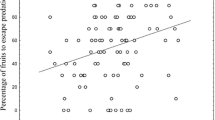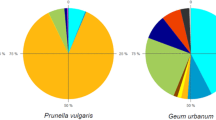Abstract
Many hypotheses suggest that pollinators act to maintain or change floral color morph frequencies in nature, although pollinator preferences do not always match color morph frequencies in the field. Therefore, non-pollinating agents may also be responsible for color morph frequencies. To test this hypothesis, we examined whether Raphanus sativus plants with white flowers received different amounts of florivory than plants with pink flowers, and whether florivores preferred one floral color over the other. We found that white-flowered plants received significantly more floral damage than pink-flowered plants in eight populations over 4 years in northern California. Both generalists and specialists on Brassicaceae preferred white petals in choice and short-term no choice tests. In performance tests, generalists gained more weight on white versus pink petals whereas specialists gained similar amounts of weight on pink and white morphs. Because our results suggest that florivores prefer and perform better on white versus pink flowers, these insects may have the opportunity to affect the frequency of color morphs in the field.



Similar content being viewed by others
References
Armbruster WS (2002) Can indirect selection and genetic context contribute to trait diversification? A transition-probability study of blossom-colour evolution in two genera. J Evol Biol 15:468–486
Clements FE, Long FL (1923) Experimental pollination, vol 336. Carnegie Institution Publication, Washington, DC
Darwin C (1876) The effects of cross and self fertilisation in the vegetable kingdom. Murray, London
Fineblum WL, Rausher MD (1997) Do floral pigmentation genes also influence resistance to enemies? The W locus in Ipomoea purpurea. Ecology 78:1646–1654
Frey FM (2004) Opposing natural selection from herbivores and pathogens may maintain floral-color variation in Claytonia virginica (Portulacaceae). Evolution 58:2426–2437
Gigord LDB, Macnair MR, Smithson A (2001) Negative frequency-dependent selection maintains a dramatic flower color polymorphism in the rewardless orchid Dactylorhiza sambucina (L.). Proc Natl Acad Sci USA 98:6253–6255
Glen DM, Jones H, Fieldsend JK (1990) Damage to oilseed rape seedlings by the field slug Deroceras reticulatum in relation to glucosinolate concentrations. Ann Appl Biol 117:197–208
Hedin PA, Jenkins JN, Collum DH, White WH, Parrott WL, Macgown MW (1983) Cyanidin-3-beta-glucoside, a newly recognized basis for resistance in cotton to the tobacco budworm heliothis virescens (Fab) (Lepidoptera, Noctuidae). Experientia 39:799–801
Hegde SG, Nason JD, Clegg JM, Ellstrand NC (2006) The evolution of California’s wild radish has resulted in the extinction of its progenitors. Evolution 60:1187–1197
Hemm MR, Ruegger MO, Chapple C (2003) The Arabidopsis ref2 mutant is defective in the gene encoding CYP83A1 and shows both phenylpropanoid and glucosinolate phenotypes. Plant Cell 15:179–194
Irwin RE, Strauss SY (2005) Flower color microevolution in wild radish: evolutionary response to pollinator-mediated selection. Am Nat 165:225–237
Irwin RE, Strauss SY, Storz S, Emerson A, Guibert G (2003) The role of herbivores in the maintenance of a flower color polymorphism in wild radish. Ecology 84:1733–1743
Johnson ET, Berhow MA, Dowd PF (2008) Colored and white sectors from star- patterned petunia flowers display differential resistance to corn earworm and cabbage looper larvae. J Chem Ecol 34:757–765
Jones KN, Reithel JS (2001) Pollinator-mediated selection on a flower color polymorphism in experimental populations of Antirrhinum (Scrophulariaceae). Am J Bot 88:447–454
Karban R, Nagasaka K (2004) Are defenses of wild radish populations well matched with variability and predictablity of herbivory? Evol Ecol 18:283–301
Koes RE, Quattrocchio F, Mol JNM (1994) The flavonoid biosynthetic-pathway in plants—function and evolution. BioEssays 16:123–132
Lankau RA (2007) Specialist and generalist herbivores exert opposing selection on a chemical defense. New Phytol 175:176–184
Lehtila K, Strauss SY (1997) Leaf damage by herbivores affects attractiveness to pollinators in wild radish, Raphanus raphanistrum. Oecologia 111:396–403
Li Q, Eigenbrode SD, Stringam GR, Thiagarajah MR (2000) Feeding and growth of Plutella xylostella and Spodoptera eridania on Brassica juncea with varying glucosinolate concentrations and myrosinase activities. J Chem Ecol 26:2401–2419
Mueller H (1883) The fertilisation of flowers. MacMillan, London
Newton E, Bullock JM, Hodgson D (2010) Temporal consistency in herbivore responses to glucosinolate polymorphism in populations of wild cabbage (Brassica oleracea). Oecologia 164:689–699
Panestsos CP (1964) Sources of Variation in Wild Populations of Raphanus (Cruciferae). PhD thesis, University of California, Berkeley
Renwick JAA (2002) The chemical world of crucivores: lures, treats and traps. Ent Exper Appl 104:35–42
Smallegange RC, van Loon JJA, Blatt SE, Harvey JA, Agerbirk N, Dicke M (2007) Flower vs. leaf feeding by Pieris brassicae: glucosinolate-rich flower tissues are preferred and sustain higher growth rate. J Chem Ecol 33:1831–1844
Stanton ML (1987) Reproductive-biology of petal color variants in wild populations of Raphanus sativus I: pollinator response to color morphs. Am J Bot 74:178–187
Strauss SY, Irwin RE (2004) Ecological and evolutionary consequences of multispecies plant–animal interactions. Annu Rev Ecol Evol Syst 35:435–466
Strauss SY, Conner JK, Rush SL (1996) Foliar herbivory affects floral characters and plant attractiveness to pollinators: implications for male and female plant fitness. Am Nat 147:1098–1107
Strauss SY, Irwin RE, Lambrix V (2004) Optimal defense theory and flower petal colour predict variation in the secondary chemistry of wild radish. J Ecol 92:132–141
Waser NM, Price MV (1981) Pollinator choice and stabilizing selection for flower color in Delphinium nelsonii. Evolution 35:376–390
Whitney KD, Stanton ML (2004) Insect seed predators as novel agents of selection on fruit color. Ecology 85:2153–2160
Acknowledgments
We would like to thank Peter Connors and Jackie Sones at the Bodega Marine Laboratory and Reserve for the use of their facilities and access to radish populations. We would also like to thank the California Department of Fish and Game for access to the YOLO site. Special thanks to Amy Chang and Amber Wright for help in the field. R. Karban, J. Lau, and T. Schultz, and two anonymous reviewers made helpful comments on an earlier version of this manuscript. These experiments comply with the current laws of the country in which the experiments were performed.
Author information
Authors and Affiliations
Corresponding author
Additional information
Communicated by Florian Schiestl.
Rights and permissions
About this article
Cite this article
McCall, A.C., Murphy, S.J., Venner, C. et al. Florivores prefer white versus pink petal color morphs in wild radish, Raphanus sativus . Oecologia 172, 189–195 (2013). https://doi.org/10.1007/s00442-012-2480-z
Received:
Accepted:
Published:
Issue Date:
DOI: https://doi.org/10.1007/s00442-012-2480-z




